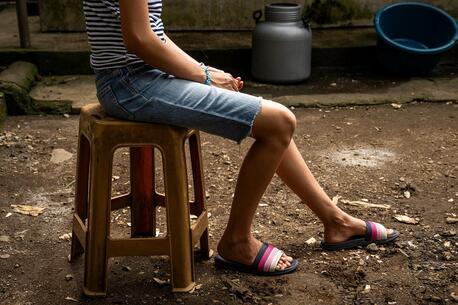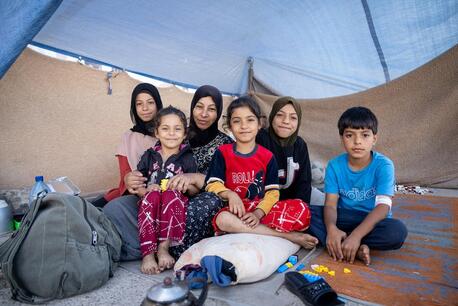
For Refugee Children, the Simple Joy of a Soccer Ball
"They call it by many names: the sphere, the round, the tool, the globe, the balloon, the projectile." — Uruguayan writer Eduardo Galeano, "Soccer in Sun and Shadow"
All children need to play. For vulnerable refugee and displaced children who suffer from trauma and toxic stress, that need is even greater. Play helps children find peace, regain a sense of normalcy and learn social skills like turn-taking and collaboration. No matter how difficult the circumstances, the pleasure of the "beautiful game" is truly universal. As the 2018 FIFA World Cup gets underway, UNICEF celebrates the simple joy that a soccer ball can bring — to boys, to girls, to children of any age.
Wherever there is no ball, people find ways to make one using any materials at hand. Pelé, Brazil’s greatest soccer hero, learned the game with a ball that his father made out of a sock stuffed with rags.
UNICEF does its best to make things easier for children and parents, placing two soccer balls into every UNICEF recreation kit — sometimes called the "magic suitcase." Tens of thousands are distributed each year, procured at local factories or shipped from the UNICEF Supply Division warehouse in Copenhagen.
UNICEF has supplied soccer balls to, among other places, camps for Rohingya refugees, Child-Friendly Spaces for hurricane survivors in the Caribbean and centers for displaced children in Mali — anywhere that children need to step away from suffering and experience the magic of play.

After a heavy rain that saturated the ground, Hafizul Mustafa, 11, a Rohingya refugee from Myanmar, plays soccer in Balukhali camp, Cox's Bazaar District, Bangladesh in May 2018. © UNICEF/UN0205641/Sokol

Nigerian refugees displaced by Boko Haram militants play football in Daresalam refugee camp, Lake Region, Chad in 2017. © UNICEF/UN067751/Sokhin

In 2017, 9-year-old Unique holds a football at the Antigua Recreation Ground (Antigua and Barbuda's national stadium), where families took shelter after Hurricane Irene. "My mom says that Irma did not defeat us," Unique said proudly. © UNICEF/UN0121370/Moreno Gonzalez

At a camp in Port-au-Prince, Haiti for people affected by the January 2010 earthquake. ©UNICEF/HTIA2010-00363/Ramoneda

Outside a family’s tent shelter in 2013 in the Tal Al Abiad settlement for Syrian refugees in Baalbek, Lebanon. ©UNICEF/NYHQ2013-1387/Noorani

Beneath a tree at the Bidi Bidi settlement for South Sudanese refugees in Uganda in 2017. ©UNICEFUSA/Ose

At a container that serves as a temporary kindergarten in a settlement for displaced persons in Sabirabad, Azerbaijan, 2004. ©UNICEF/NYHQ2004-0607/Pirozzi

In a field used for play by refugees from Kosovo in 1998, near the town of Bajram Curri, Albania. © UNICEF/NYHQ1998-0383/LeMoyne
Help UNICEF and partners support and protect refugee and migrant children around the world.
Top photo: In 2016, at a UNICEF Child-Friendly Space in war-torn Sa’ada, Yemen. © UNICEF/UN026935/Rahmah
HOW TO HELP
There are many ways to make a difference
War, famine, poverty, natural disasters — threats to the world's children keep coming. But UNICEF won't stop working to keep children healthy and safe.
UNICEF works in over 190 countries and territories — more places than any other children's organization. UNICEF has the world's largest humanitarian warehouse and, when disaster strikes, can get supplies almost anywhere within 72 hours. Constantly innovating, always advocating for a better world for children, UNICEF works to ensure that every child can grow up healthy, educated, protected and respected.
Would you like to help give all children the opportunity to reach their full potential? There are many ways to get involved.




